Fast Facts & Figures About Social Security, 2012
- Did You
Know That... - General
Information - Income of the
Aged Population
OASDI Program
SSI Program- Cross-Program
Beneficiaries - Social Security
Financing
Did You Know That...
- SSA paid benefits to about 60.4 million people in 2011
- Social Security provided at least half the income for 65 percent of the aged beneficiaries in 2010
- Social Security benefits were awarded to about 5.6 million people in 2011
- Women accounted for 56 percent of adult Social Security beneficiaries in 2011
- The average age of disabled-worker beneficiaries was 53.0 in 2011
- Eighty-five percent of SSI recipients received payments because of disability or blindness in 2011
General Information
| Program | Employee a | Employer | Self-employed a |
|---|---|---|---|
| Total | 5.65 | 7.65 | 13.30 |
| OASI | 3.59 | 5.30 | 8.89 |
| DI | 0.61 | 0.90 | 1.51 |
| HI | 1.45 | 1.45 | 2.90 |
| a. Recent legislation reduced the 2012 OASDI tax rates by two percentage points for employees (from 6.2 percent to 4.2 percent) and for the self-employed (from 12.4 percent to 10.4 percent). The Department of the Treasury will make up the reductions in tax revenue due to lower tax rates by transferring money from the general fund of the Treasury to the OASI and DI trust funds. SSA will credit workers with the full amount of taxable earnings. | |||
| Type of earner | Total | OASI | DI | HI |
|---|---|---|---|---|
| Average earner | 2,522 | 1,603 | 272 | 647 |
| Maximum earner | 4,624 | 3,953 | 672 | No limit |
| Self-employed maximum earner | 11,450 | 9,788 | 1,662 | No limit |
| NOTE: Totals do not necessarily equal the sum of rounded components. | ||||
| Program | Amount |
|---|---|
| OASDI | 110,100 |
| HI | No limit |
| Amount | |
|---|---|
| One work credit (one quarter of coverage) | 1,130 |
| Maximum of four credits a year | 4,520 |
| Age of retired person in 2012 | Annually | Monthly |
|---|---|---|
| Under full retirement age ($1 for $2 withholding rate) | 14,640 | 1,220 |
| Full retirement age ($1 for $3 withholding rate) a | 38,880 | 3,240 |
| Above full retirement age | No limit | No limit |
| a. The test applies only to earnings made in months prior to the month of attainment of full retirement age. | ||
| Calendar year | Total | OASI | DI |
|---|---|---|---|
| 2010 | 4.79 | 3.94 | 0.85 |
| 2011 | 4.80 | 3.95 | 0.85 |
| NOTE: Figures are subject to change. | |||
Cost-of-living adjustment, 2012: 3.6%
Maximum monthly Social Security benefit:
$2,513 per month for workers retiring at full retirement age in 2012
NOTE: Higher benefits are possible for those who work or delay benefit receipt after reaching full retirement age.
| Year of birth | Full retirement age |
|---|---|
| 1937 and earlier | 65 |
| 1938 | 65 and 2 months |
| 1939 | 65 and 4 months |
| 1940 | 65 and 6 months |
| 1941 | 65 and 8 months |
| 1942 | 65 and 10 months |
| 1943–1954 | 66 |
| 1955 | 66 and 2 months |
| 1956 | 66 and 4 months |
| 1957 | 66 and 6 months |
| 1958 | 66 and 8 months |
| 1959 | 66 and 10 months |
| 1960 and later | 67 |
Benefit formula bend points (for workers with first eligibility in 2012):
Primary insurance amount (PIA) equals
90% of the first $767 of AIME, plus
32% of AIME over $767 through $4,624, plus
15% of AIME over $4,624
| Year | Dollars | Increase from previous year (in percent) |
|---|---|---|
| 2010 | 41,673.83 | 2.4 |
| 2011 (estimated) | 43,008.96 | 3.2 |
| 2012 (estimated) | 44,644.06 | 3.8 |
| Individual | Couple | |
|---|---|---|
| Federal benefit rate | 698 | 1,048 |
| Resource limits | 2,000 | 3,000 |
Disability thresholds
Substantial gainful activity
- $1,010 per month for nonblind persons
- $1,690 per month for blind persons
Trial work period
- $720 per month
| Family unit | Amount |
|---|---|
| Aged individual | 10,788 |
| Family of two, aged head | 13,596 |
| Family of four | 23,201 |
| SOURCE: U.S. Census Bureau as of January 2012 (preliminary estimates). | |
| Calendar year and trust fund | Income | Outgo | Fund at end of year |
|---|---|---|---|
| 2011 (actual) | |||
| Total | 805.1 | 736.1 | 2,677.9 |
| OASI | 698.8 | 603.8 | 2,524.1 |
| DI | 106.3 | 132.3 | 153.9 |
| 2012 (estimated) | |||
| Total | 846.0 | 788.7 | 2,735.2 |
| OASI | 735.7 | 647.2 | 2,612.6 |
| DI | 110.2 | 141.5 | 122.6 |
| NOTE: Totals do not necessarily equal the sum of rounded components. | |||
OASDI administrative expenses: Costs were 0.9% of contributions in calendar year 2011
| Type of filing | Number |
|---|---|
| OASI claims | 4.8 |
| DI claims | 3.6 |
| SSI applications | 3.2 |
Income of the Aged Population
Size of Income, 1962 and 2010
Median annual income for married couples and nonmarried persons aged 65 or older has increased markedly since 1962 (the earliest year for which data are available). Even after adjusting for inflation, median income has risen 115% for married couples and 112% for nonmarried persons. A married couple is aged 65 or older if the husband is aged 65 or older or if the husband is aged 54 or younger and the wife is 65 or older.
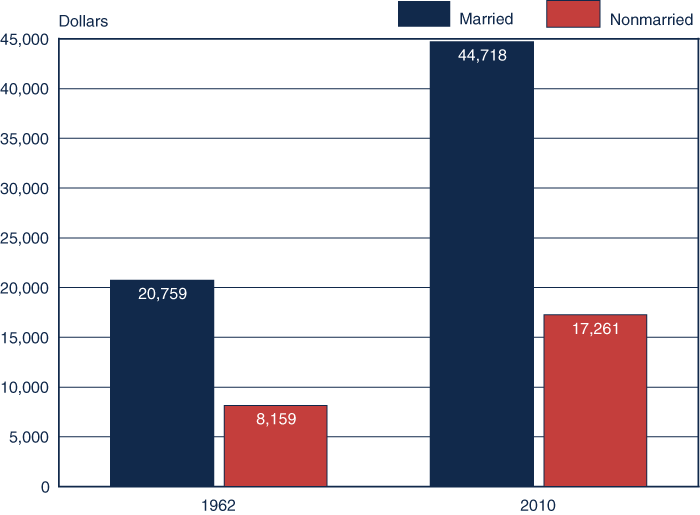
Receipt of Income, 1962 and 2010
Social Security benefits—the most common source of income for married couples and nonmarried persons aged 65 or older in 1962—are now almost universal. The proportion of the aged population with asset income—the next most common source—is similar to that in 1962. Over the 48-year period, receipt of private pensions has tripled, and receipt of government pensions has increased by more than 50%. The proportion of couples and nonmarried persons aged 65 or older who had earnings was smaller in 2010 than in 1962.
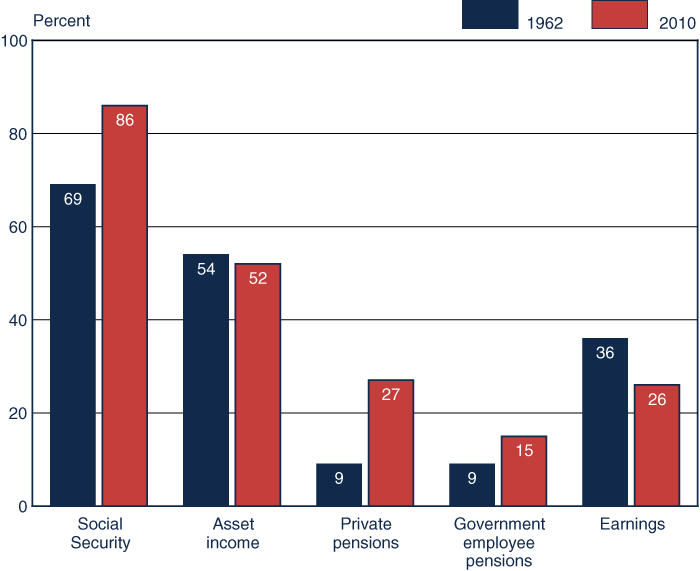
| Source of income | 1962 | 2010 |
|---|---|---|
| Social Security | 69 | 86 |
| Asset income | 54 | 52 |
| Private pensions | 9 | 27 |
| Government employee pensions | 9 | 15 |
| Earnings | 36 | 26 |
Shares of Aggregate Income, 1962 and 2010
In 1962, Social Security, private and government employee pensions, income from assets, and earnings made up only 84% of the aggregate total income of couples and nonmarried persons aged 65 or older, compared with 96% in 2010. The shares from Social Security, private pensions, and government employee pensions have increased since 1962. The share from earnings in 2010 is about the same as it was in 1962, while the share from asset income is lower.
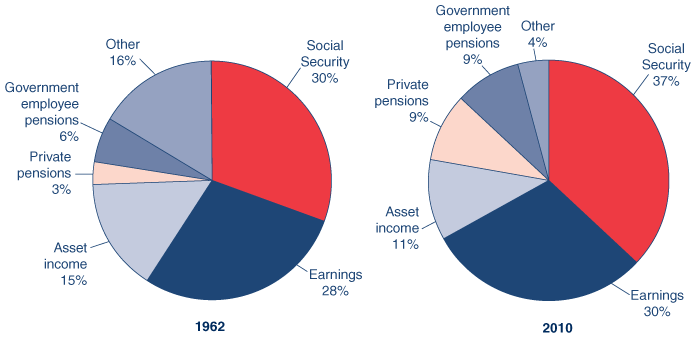
| Income source | 1962 | 2010 |
|---|---|---|
| Social Security | 30 | 37 |
| Earnings | 28 | 30 |
| Asset income | 15 | 11 |
| Private pensions | 3 | 9 |
| Government employee pensions | 6 | 9 |
| Other | 16 | 4 |
Relative Importance of Social Security, 2010
In 2010, 88% of married couples and 85% of nonmarried persons aged 65 or older received Social Security benefits. Social Security was the major source of income (providing at least 50% of total income) for 53% of aged beneficiary couples and 74% of aged nonmarried beneficiaries. It was 90% or more of income for 23% of aged beneficiary couples and 46% of aged nonmarried beneficiaries. Total income excludes withdrawals from savings and nonannuitized IRAs or 401(k) plans; it also excludes in-kind support, such as food stamps and housing and energy assistance.
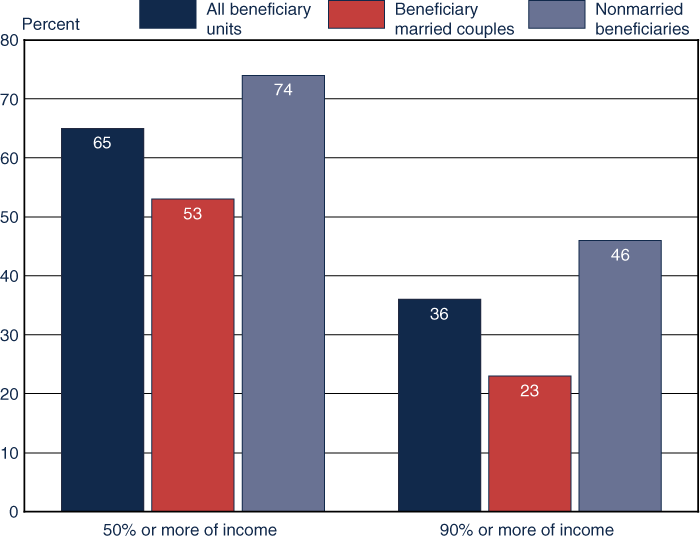
Poverty Status Based on Family Income, 2010
The aged poor are those with income below the poverty line. The near poor have income greater than or equal to the poverty line and less than 125% of the poverty line. Nonmarried women and minorities have the highest poverty rates, ranging from 15.8% to 18.0%. Married persons have the lowest poverty rates, with 4.2% poor and 3.1% near poor. Overall, 9.0% are poor and 5.7% are near poor.
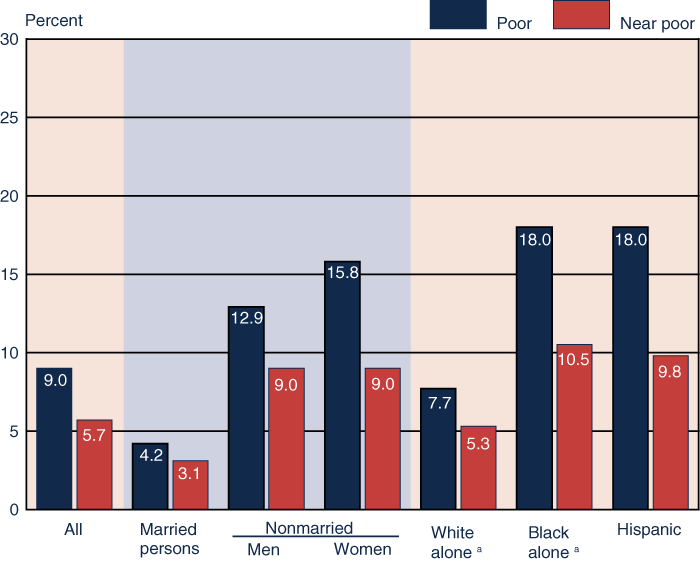
| Characteristic | Percent poor |
Percent near poor |
|---|---|---|
| All persons | 9.0 | 5.7 |
| By marital status | ||
| Married | 4.2 | 3.1 |
| Nonmarried men | 12.9 | 9.0 |
| Nonmarried women | 15.8 | 9.0 |
| By race and Hispanic origin | ||
| White alone a | 7.7 | 5.3 |
| Black alone a | 18.0 | 10.5 |
| Hispanic | 18.0 | 9.8 |
OASDI Program
Earnings in Covered Employment, 1937–2011
People contribute to Social Security through payroll taxes or self-employment taxes, as required by the Federal Insurance Contributions Act (FICA) and the Self-Employment Contributions Act (SECA). The maximum taxable amount is updated annually on the basis of increases in the average wage. Of the 158 million workers with earnings in Social Security–covered employment in 2011, 6% had earnings that equaled or exceeded the maximum amount subject to taxes, compared with 3% when the program began and a peak of 36% in 1965. About 83% of earnings in covered employment were taxable in 2011, compared with 92% in 1937.
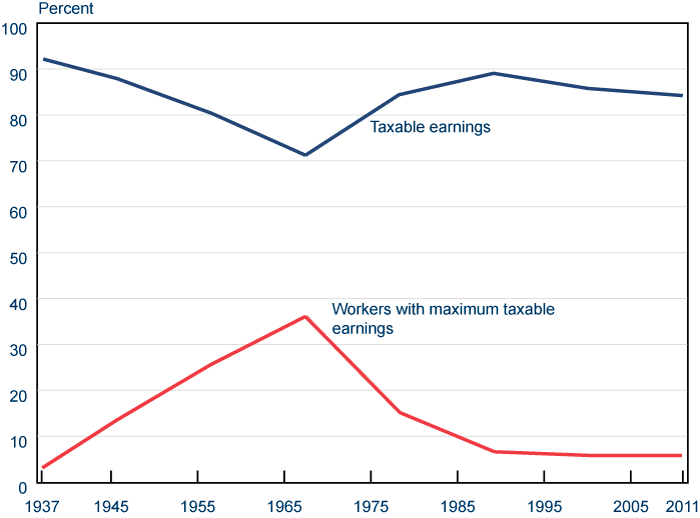
Insured Status, 1970–2011
The percentage of persons aged 20 or older who are insured for benefits has remained the same for the past several years. To be fully insured, a worker must have at least one work credit (quarter of coverage) for each year elapsed after age 21 (but no earlier than 1950) and before the year in which he or she attains age 62, becomes disabled, or dies. The maximum number of work credits needed to be fully insured is 40. An individual is said to be permanently insured if he or she has earned 40 work credits. To be insured for disability, the worker must be fully insured and have at least 20 work credits during the last 40 calendar quarters. (Requirements for disability-insured status are somewhat different for persons younger than age 31.) Disability benefits are available up to full retirement age (FRA).
| Year | Population aged 20 or older | Population aged 20 to full retirement agea | |||
|---|---|---|---|---|---|
| Millions | Percentage permanently insured |
Percentage fully insured |
Millions | Percentage insured for disability |
|
| 1970 | 134.9 | 50 | 78 | 113.8 | 63 |
| 1975 | 147.1 | 51 | 81 | 123.6 | 66 |
| 1980 | 161.6 | 53 | 83 | 135.1 | 70 |
| 1985 | 174.8 | 58 | 84 | 145.4 | 72 |
| 1990 | 185.8 | 63 | 86 | 153.6 | 75 |
| 1995 | 195.9 | 66 | 87 | 161.3 | 76 |
| 2000 | 206.6 | 68 | 87 | 170.8 | 78 |
| 2005 | 218.2 | 69 | 88 | 181.8 | 78 |
| 2010 | 231.4 | 69 | 87 | 192.7 | 77 |
| 2011 | 233.9 | 70 | 87 | 191.3 | 78 |
| SOURCE: Social Security Administration, Office of the Chief Actuary. | |||||
| NOTES: The population in the Social Security area includes residents of the 50 states and the District of Columbia adjusted for net census undercount; civilian residents of American Samoa, Guam, Northern Mariana Islands, Puerto Rico, and U.S. Virgin Islands; federal civilian employees and persons in the armed forces abroad and their dependents; crew members of merchant vessels; and all other U.S. citizens abroad. | |||||
| Figures are subject to revision. | |||||
| a. Insured for disability excludes those who have reached full retirement age. | |||||
Insured Status, by Sex, 1970 and 2011
Although men are more likely than women to be insured, the gender gap is shrinking. The proportion of men who are insured has remained essentially stable, with 90% fully insured and 80% insured for disability. By contrast, the proportion of women who are insured has increased dramatically—from 63% to 85% fully insured and from 41% to 73% insured for disability.
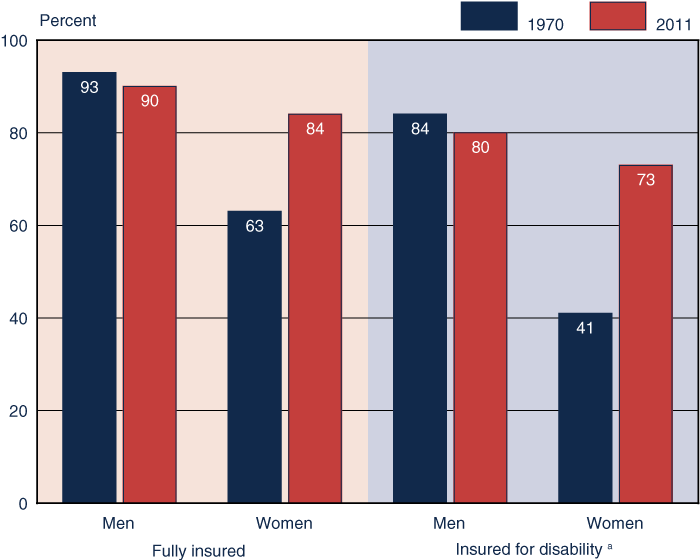
| Sex | 1970 | 2011 |
|---|---|---|
| Fully insured | ||
| Men | 93 | 90 |
| Women | 63 | 84 |
| Insured for disability a | ||
| Men | 84 | 80 |
| Women | 41 | 73 |
New Benefit Awards, 2011
Benefits were awarded to about 5.6 million persons; of those, 46% were retired workers and 18% were disabled workers. The remaining 36% were survivors or the spouses and children of retired or disabled workers. These awards represent not only new entrants to the benefit rolls but also persons already on the rolls who become entitled to a different benefit, particularly conversions of disabled-worker benefits to retired-worker benefits at full retirement age.
| Beneficiary | Number (thousands) |
Percent |
|---|---|---|
| Total | 5,567 | 100 |
| Retired workers and dependents | 3,076 | 55 |
| Workers | 2,578 | 46 |
| Spouses and children | 498 | 9 |
| Disabled workers and dependents | 1,605 | 28 |
| Workers | 999 | 18 |
| Spouses and children | 606 | 11 |
| Survivors of deceased workers | 886 | 16 |
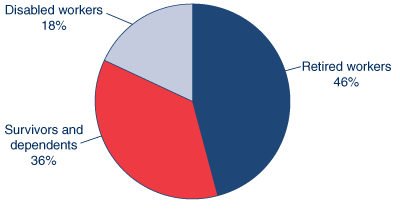
New Awards to Workers, 1971–2011
Awards to retired workers have increased considerably over the past four decades, but proportionately much less than awards to disabled workers. The annualized rate of increase over the period from 1971 to 2011 is 1.6% for retired workers and 2.2% for disabled workers. The annual number of awards to retired workers rose from 1.4 million in 1971 to 2.6 million in 2011, while for disabled workers it increased from 416,000 in 1971 to 1.0 million in 2011.
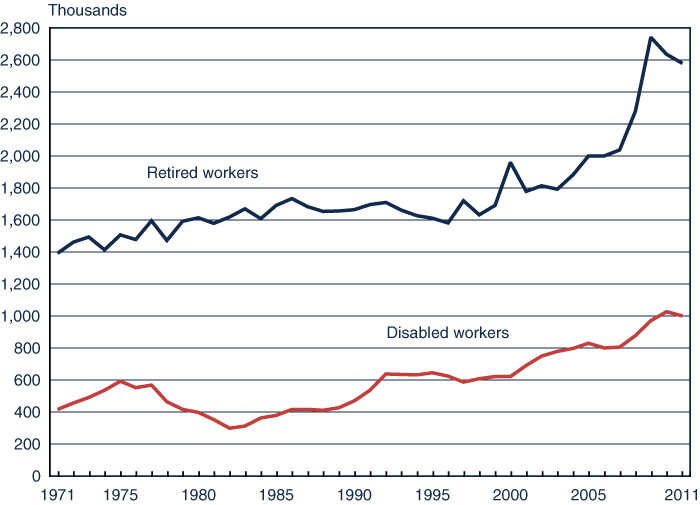
| Year | Retired workers |
Disabled workers |
|---|---|---|
| 1971 | 1,391.40 | 415.90 |
| 1972 | 1,461.40 | 455.44 |
| 1973 | 1,493.19 | 491.62 |
| 1974 | 1,413.15 | 535.98 |
| 1975 | 1,505.75 | 592.05 |
| 1976 | 1,475.77 | 551.46 |
| 1977 | 1,593.63 | 568.87 |
| 1978 | 1,472.79 | 464.42 |
| 1979 | 1,590.85 | 416.71 |
| 1980 | 1,612.67 | 396.56 |
| 1981 | 1,578.99 | 351.85 |
| 1982 | 1,618.41 | 297.13 |
| 1983 | 1,669.74 | 311.55 |
| 1984 | 1,607.37 | 362.00 |
| 1985 | 1,690.49 | 377.37 |
| 1986 | 1,734.25 | 416.87 |
| 1987 | 1,681.72 | 415.85 |
| 1988 | 1,654.07 | 409.49 |
| 1989 | 1,656.74 | 425.58 |
| 1990 | 1,664.75 | 467.98 |
| 1991 | 1,695.35 | 536.43 |
| 1992 | 1,707.95 | 636.64 |
| 1993 | 1,661.28 | 635.24 |
| 1994 | 1,625.35 | 631.87 |
| 1995 | 1,609.17 | 645.83 |
| 1996 | 1,581.45 | 624.34 |
| 1997 | 1,718.62 | 587.42 |
| 1998 | 1,631.51 | 608.13 |
| 1999 | 1,690.02 | 620.49 |
| 2000 | 1,960.65 | 621.65 |
| 2001 | 1,779.23 | 691.31 |
| 2002 | 1,812.55 | 750.00 |
| 2003 | 1,791.32 | 777.46 |
| 2004 | 1,883.06 | 795.78 |
| 2005 | 2,000.00 | 830.00 |
| 2006 | 1,999.00 | 799.00 |
| 2007 | 2,036.00 | 805.00 |
| 2008 | 2,279.00 | 877.00 |
| 2009 | 2,740.00 | 971.00 |
| 2010 | 2,634.00 | 1,027.00 |
| 2011 | 2,578.00 | 999.00 |
Beneficiaries in Current-Payment Status, December 2011
More than 55 million beneficiaries were in current-payment status, that is, they were being paid a benefit. Sixty-four percent of those beneficiaries were retired workers and 15% were disabled workers. The remaining 21% were survivors or the spouses and children of retired or disabled workers.
| Beneficiary | Number (thousands) |
Percent |
|---|---|---|
| Total | 55,404 | 100 |
| Retired workers and dependents | 38,486 | 69 |
| Workers | 35,600 | 64 |
| Spouses and children | 2,886 | 5 |
| Disabled workers and dependents | 10,613 | 19 |
| Workers | 8,576 | 15 |
| Spouses and children | 2,038 | 4 |
| Survivors of deceased workers | 6,305 | 11 |
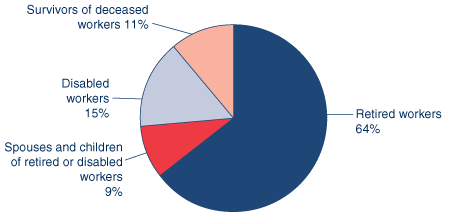
Average Benefit Amounts, 2011
Benefits payable to workers who retire at the full retirement age and to disabled workers are equal to 100% of the PIA (subject to any applicable deductions). At the full retirement age, widow(er)s' benefits are also payable at 100% of the insured worker's PIA. Nondisabled widow(er)s can receive reduced benefits at age 60. Disabled widow(er)s can receive reduced benefits at age 50. Spouses, children, and parents receive a smaller proportion of the worker's PIA than do widow(er)s.
| Beneficiary | New awards | Benefits in current-payment status, December |
|---|---|---|
| Retired workers | 1,241 | 1,229 |
| Spouses | 463 | 607 |
| Children | 562 | 603 |
| Disabled workers | 1,189 | 1,111 |
| Spouses | 306 | 299 |
| Children | 306 | 330 |
| Survivors of deceased workers | ||
| Nondisabled widow(er)s | 951 | 1,185 |
| Disabled widow(er)s | 682 | 704 |
| Widowed mothers and fathers | 848 | 884 |
| Surviving children | 779 | 783 |
| Parents | 1,034 | 1,045 |
| SOURCE: Social Security Administration, Master Beneficiary Record, 100 percent data. | ||
Beneficiaries, by Age, December 2011
About four-fifths of all OASDI beneficiaries in current-payment status were aged 62 or older, including 22 percent aged 75–84 and 10 percent aged 85 or older. About 15 percent were persons aged 18–61 receiving benefits as disabled workers, survivors, or dependents. Another 6 percent were children under age 18.
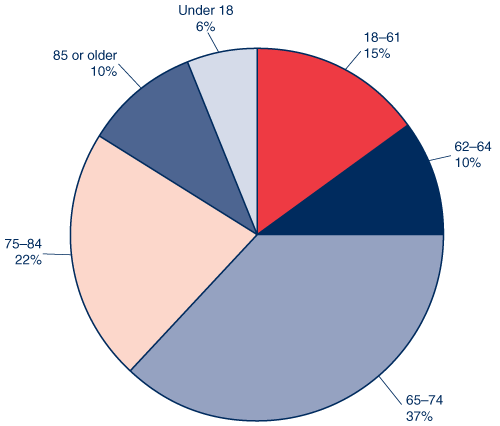
Disabled and Retired Workers, by Age, 1960–2011
The average age of disabled-worker beneficiaries in current-payment status has declined substantially since 1960, when DI benefits first became available to persons younger than age 50. In that year, the average age of a disabled worker was 57.2 years. The rapid drop in average age in the following years reflects a growing number of awards to workers under 50. By 1995, the average age had fallen to a low of 49.8, and by 2011, it had risen to 53.0. By contrast, the average age of retired workers has changed little over time, rising from 72.4 in 1960 to 73.7 in 2011.
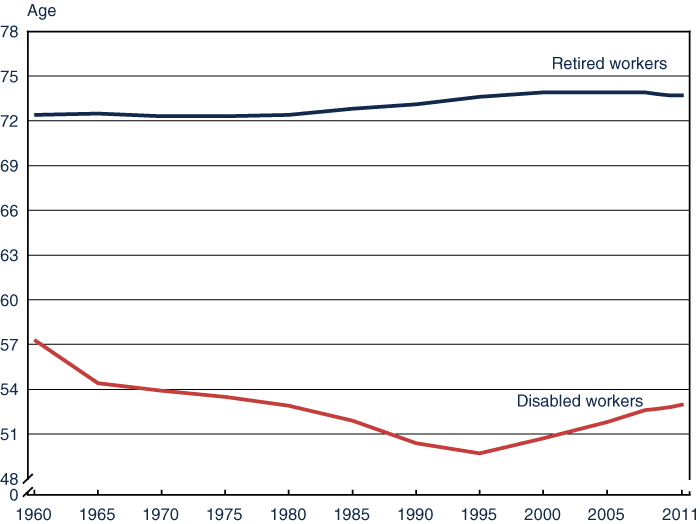
| Year | Disabled workers |
Retired workers |
|---|---|---|
| 1960 | 57.2 | 72.4 |
| 1965 | 54.7 | 72.5 |
| 1970 | 54.2 | 72.3 |
| 1975 | 53.8 | 72.3 |
| 1980 | 53.2 | 72.4 |
| 1985 | 52.1 | 72.8 |
| 1990 | 50.5 | 73.1 |
| 1995 | 49.8 | 73.6 |
| 2000 | 50.8 | 73.9 |
| 2005 | 51.8 | 73.9 |
| 2006 | 52.1 | 74.0 |
| 2007 | 52.4 | 74.0 |
| 2008 | 52.6 | 73.9 |
| 2009 | 52.7 | 73.8 |
| 2010 | 52.8 | 73.7 |
| 2011 | 53.0 | 73.7 |
Beneficiaries, by Sex, December 2011
Of all adults receiving monthly Social Security benefits, 44% were men and 56% were women. Seventy-nine percent of the men and 62% of the women received retired-worker benefits. About one-sixth of the women received survivor benefits.
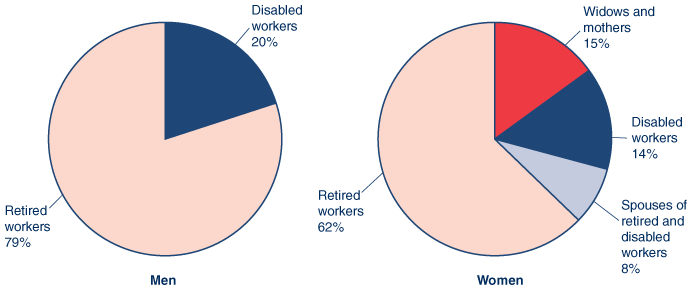
Average Monthly Benefit, by Sex, December 2011
Among retired and disabled workers who collected benefits based on their own work records, men received a higher average monthly benefit than did women. For those with benefits based on another person's work record (spouses and survivors), women had higher average benefits.
| Beneficiary | Men | Women |
|---|---|---|
| Workers | ||
| Retired | 1,381 | 1,072 |
| Disabled | 1,237 | 972 |
| Spouses of— | ||
| Retired workers | 398 | 613 |
| Disabled workers | 257 | 300 |
| Survivors of deceased workers | ||
| Nondisabled widow(er)s | 1,028 | 1,188 |
| Disabled widow(er)s | 515 | 714 |
| Mothers and fathers | 756 | 894 |
| SOURCE: Social Security Administration, Master Beneficiary Record, 100 percent data. | ||
Women Beneficiaries, 1940–2011
The proportion of women among retired-worker beneficiaries has quadrupled since 1940. The percentage climbed from 12% in 1940 to 47% in 1980, 48% in 1990, and 49% in 2011. The proportion of women among disabled-worker beneficiaries has more than doubled since 1957, when DI benefits first became payable. The percentage rose steadily from 19% in 1957 to 35% in 1990 and 48% in 2011.
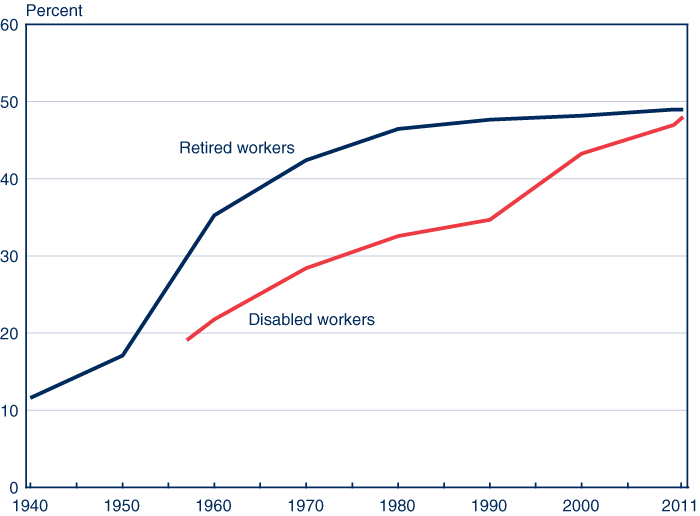
| Year | Retired workers |
Disabled workers |
|---|---|---|
| 1940 | 11.6 | -- |
| 1950 | 17.1 | -- |
| 1957 | -- | 19.1 |
| 1960 | 35.3 | 21.8 |
| 1970 | 42.4 | 28.4 |
| 1980 | 46.5 | 32.6 |
| 1990 | 47.7 | 34.7 |
| 2000 | 48.2 | 43.3 |
| 2005 | 48.6 | 46.0 |
| 2006 | 49.0 | 46.0 |
| 2007 | 49.0 | 47.0 |
| 2008 | 49.0 | 47.0 |
| 2009 | 49.0 | 47.0 |
| 2010 | 49.0 | 47.0 |
| 2011 | 49.0 | 48.0 |
| NOTE: -- = not available. | ||
Women with Dual Entitlement, 1960–2011
The proportion of women aged 62 or older who are receiving benefits as dependents (that is, on the basis of their husbands' earnings record only) has been declining—from 57% in 1960 to 25% in 2011. At the same time, the proportion of women with dual entitlement (that is, paid on the basis of both their own earnings records and those of their husbands) has been increasing—from 5% in 1960 to 27% in 2011.
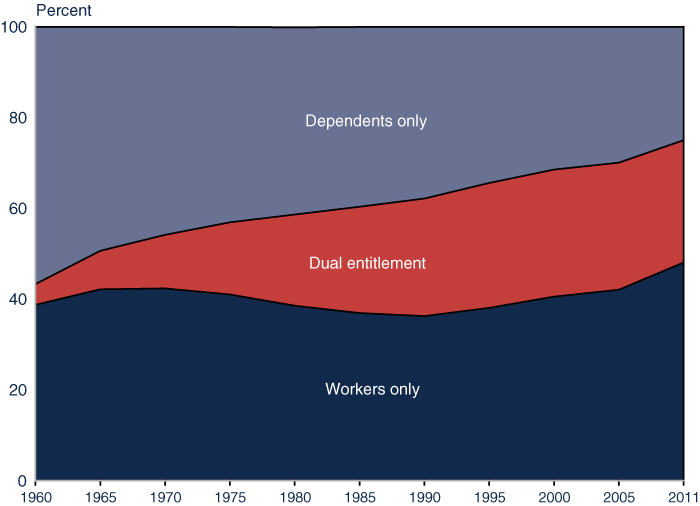
Child Beneficiaries, December 2011
Nearly 3.4 million children under age 18 and students aged 18–19 received OASDI benefits. Children of deceased workers had the highest average payments, in part because they are eligible to receive monthly benefits based on 75% of the worker's PIA, compared with 50% for children of retired or disabled workers. Overall, the average monthly benefit amount for children was $524.
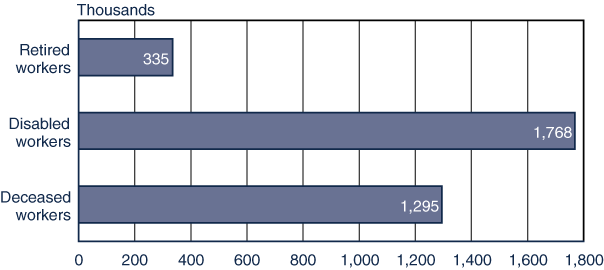
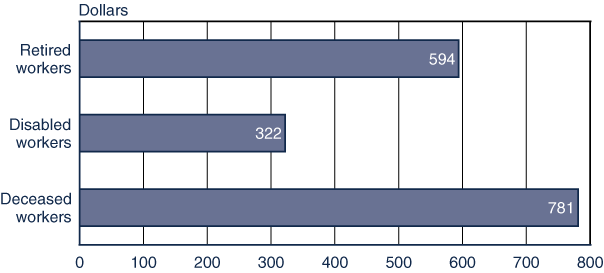
| Type of beneficiary | Number (thousands) |
Average monthly benefit (dollars) |
|---|---|---|
| Children of retired workers | 335 | 594 |
| Children of disabled workers | 1,768 | 322 |
| Children of deceased workers | 1,295 | 781 |
SSI Program
Number of Recipients, 1974–2011
The Supplemental Security Income (SSI) program provides income support to needy persons aged 65 or older, blind or disabled adults, and blind or disabled children. Eligibility requirements and federal payment standards are nationally uniform. SSI replaced the former federal/state adult assistance programs in the 50 states and the District of Columbia.
Payments under SSI began in January 1974, with 3.2 million persons receiving federally administered payments. By December 1974, this number had risen to nearly 4 million and remained at about that level until the mid-1980s, then rose steadily, reaching nearly 6 million in 1993 and 7 million by the end of 2004. As of December 2011, the number of recipients was about 8.1 million. Of this total, almost 4.8 million were between the ages of 18 and 64, 2.1 million were aged 65 or older, and 1.3 million were under age 18.
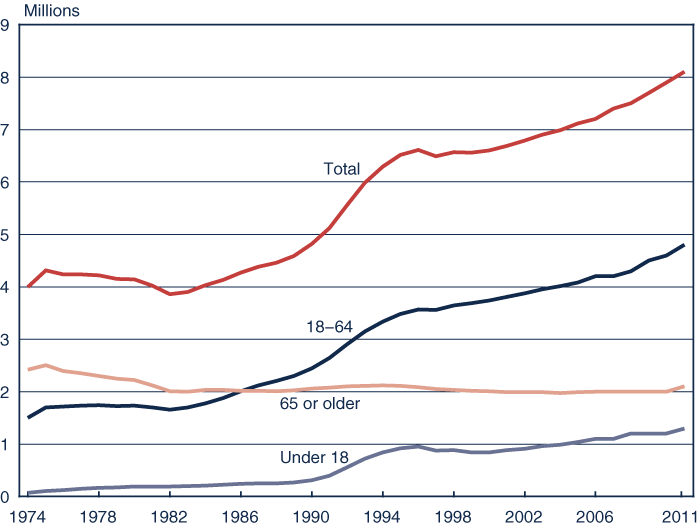
| Year | Total | Under 18 | 18–64 | 65 or older |
|---|---|---|---|---|
| 1974 | 4.0 | 0.1 | 1.5 | 2.4 |
| 1975 | 4.3 | 0.1 | 1.7 | 2.5 |
| 1976 | 4.2 | 0.1 | 1.7 | 2.4 |
| 1977 | 4.2 | 0.1 | 1.7 | 2.4 |
| 1978 | 4.2 | 0.2 | 1.7 | 2.3 |
| 1979 | 4.1 | 0.2 | 1.7 | 2.2 |
| 1980 | 4.1 | 0.2 | 1.7 | 2.2 |
| 1981 | 4.0 | 0.2 | 1.7 | 2.1 |
| 1982 | 3.9 | 0.2 | 1.7 | 2.0 |
| 1983 | 3.9 | 0.2 | 1.7 | 2.0 |
| 1984 | 4.0 | 0.2 | 1.8 | 2.0 |
| 1985 | 4.1 | 0.2 | 1.9 | 2.0 |
| 1986 | 4.3 | 0.2 | 2.0 | 2.0 |
| 1987 | 4.4 | 0.3 | 2.1 | 2.0 |
| 1988 | 4.5 | 0.3 | 2.2 | 2.0 |
| 1989 | 4.6 | 0.3 | 2.3 | 2.0 |
| 1990 | 4.8 | 0.3 | 2.4 | 2.1 |
| 1991 | 5.1 | 0.4 | 2.6 | 2.1 |
| 1992 | 5.6 | 0.6 | 2.9 | 2.1 |
| 1993 | 6.0 | 0.7 | 3.1 | 2.1 |
| 1994 | 6.3 | 0.8 | 3.3 | 2.1 |
| 1995 | 6.5 | 0.9 | 3.5 | 2.1 |
| 1996 | 6.6 | 1.0 | 3.6 | 2.1 |
| 1997 | 6.5 | 0.9 | 3.6 | 2.1 |
| 1998 | 6.6 | 0.9 | 3.6 | 2.0 |
| 1999 | 6.6 | 0.8 | 3.7 | 2.0 |
| 2000 | 6.6 | 0.8 | 3.7 | 2.0 |
| 2001 | 6.7 | 0.9 | 3.8 | 2.0 |
| 2002 | 6.8 | 0.9 | 3.9 | 2.0 |
| 2003 | 6.9 | 1.0 | 4.0 | 2.0 |
| 2004 | 7.0 | 1.0 | 4.0 | 2.0 |
| 2005 | 7.1 | 1.0 | 4.1 | 2.0 |
| 2006 | 7.2 | 1.1 | 4.2 | 2.0 |
| 2007 | 7.4 | 1.1 | 4.2 | 2.0 |
| 2008 | 7.5 | 1.2 | 4.3 | 2.0 |
| 2009 | 7.7 | 1.2 | 4.5 | 2.0 |
| 2010 | 7.9 | 1.2 | 4.6 | 2.0 |
| 2011 | 8.1 | 1.3 | 4.8 | 2.1 |
Payment Amounts, by Age, December 2011
The average monthly federally administered SSI payment was $502. Payments varied by age group, ranging from an average of $601 for recipients aged under 18 to $403 for those aged 65 or older. The maximum federal benefit rate in December 2011 was $674 for an individual and $1,011 for a couple, plus any applicable state supplementation.
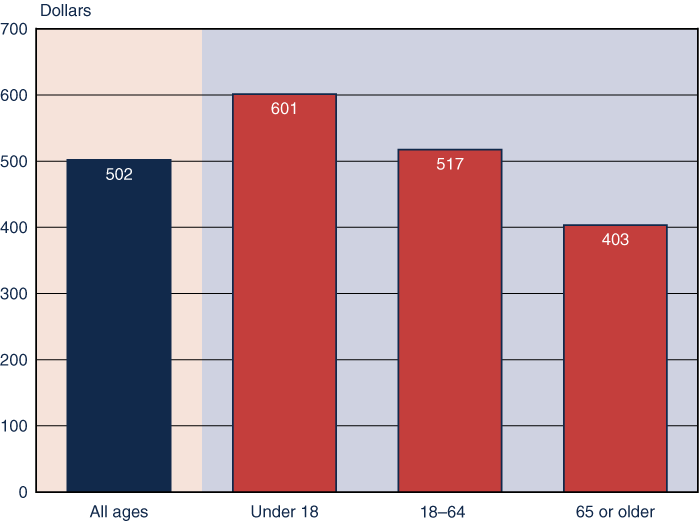
Federally Administered Payments, December 2011
A total of 8.1 million persons received federally administered SSI payments. The majority received federal SSI only. States have the option of supplementing the federal benefit rate and are required to do so if that rate is less than the income the recipient would have had under the former state program.
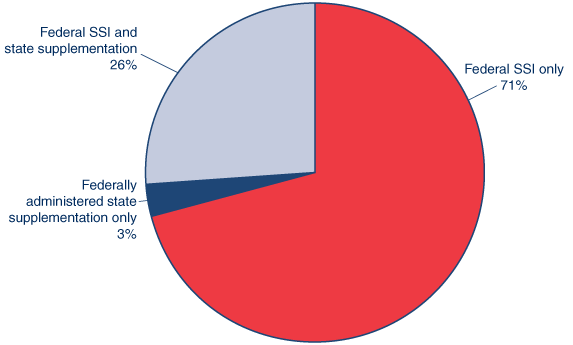
Basis for Eligibility and Age of Recipients, December 2011
Fifteen percent of SSI recipients received benefits on the basis of age, the rest on the basis of disability. Twenty-five percent of the recipients were aged 65 or older. In the SSI program, a disabled recipient is still classified as "disabled" after reaching age 65. In the OASDI program, DI beneficiaries are converted to the retirement program when they attain full retirement age.
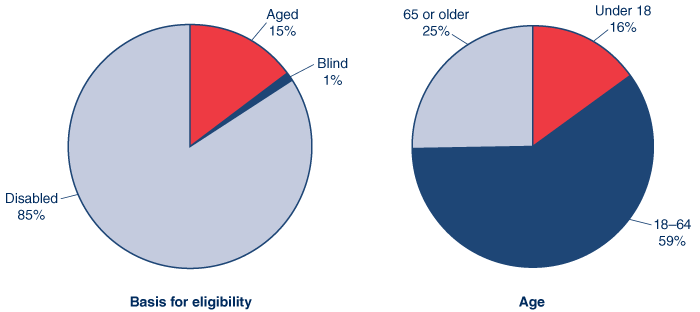
Percentage Distribution of Recipients, by Age, 1974–2011
The proportion of SSI recipients aged 65 or older has declined from 61% in January 1974 to 25% in December 2011. The overall long-term growth of the SSI program has occurred because of an increase in the number of disabled recipients, most of whom are under age 65.
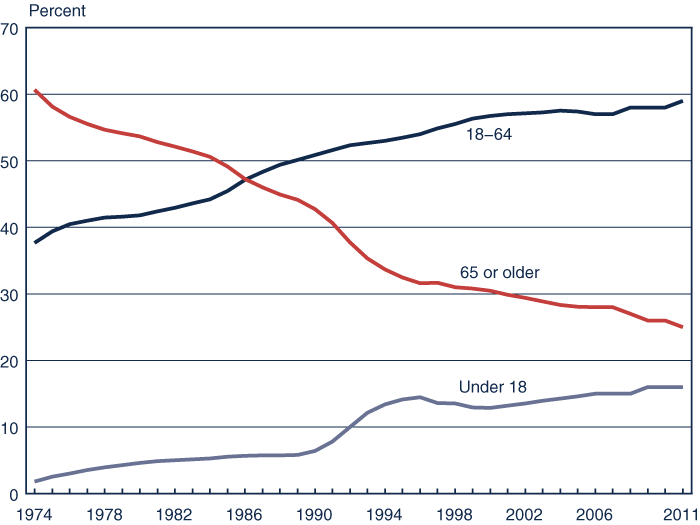
| Year | Under 18 | 18–64 | 65 or older |
|---|---|---|---|
| 1974 | 1.8 | 37.6 | 60.6 |
| 1975 | 2.5 | 39.4 | 58.1 |
| 1976 | 3.0 | 40.5 | 56.6 |
| 1977 | 3.5 | 41.0 | 55.5 |
| 1978 | 3.9 | 41.4 | 54.6 |
| 1979 | 4.3 | 41.6 | 54.1 |
| 1980 | 4.6 | 41.8 | 53.6 |
| 1981 | 4.8 | 42.4 | 52.8 |
| 1982 | 5.0 | 42.9 | 52.1 |
| 1983 | 5.1 | 43.6 | 51.3 |
| 1984 | 5.3 | 44.2 | 50.6 |
| 1985 | 5.5 | 45.4 | 49.1 |
| 1986 | 5.6 | 47.1 | 47.3 |
| 1987 | 5.7 | 48.3 | 46.0 |
| 1988 | 5.7 | 49.3 | 44.9 |
| 1989 | 5.8 | 50.1 | 44.1 |
| 1990 | 6.4 | 50.9 | 42.7 |
| 1991 | 7.8 | 51.6 | 40.6 |
| 1992 | 10.0 | 52.3 | 37.7 |
| 1993 | 12.1 | 52.6 | 35.3 |
| 1994 | 13.4 | 53.0 | 33.7 |
| 1995 | 14.1 | 53.5 | 32.5 |
| 1996 | 14.4 | 54.0 | 31.6 |
| 1997 | 13.5 | 54.8 | 31.6 |
| 1998 | 13.5 | 55.5 | 31.0 |
| 1999 | 12.9 | 56.3 | 30.8 |
| 2000 | 12.8 | 56.7 | 30.5 |
| 2001 | 13.2 | 57.0 | 29.8 |
| 2002 | 13.5 | 57.1 | 29.4 |
| 2003 | 13.9 | 57.3 | 28.8 |
| 2004 | 14.2 | 57.5 | 28.3 |
| 2005 | 14.6 | 57.4 | 28.0 |
| 2006 | 14.9 | 57.4 | 27.7 |
| 2007 | 15.2 | 57.4 | 27.4 |
| 2008 | 15.3 | 57.6 | 27.0 |
| 2009 | 15.6 | 58.0 | 26.4 |
| 2010 | 15.7 | 58.5 | 25.8 |
| 2011 | 15.7 | 58.9 | 25.4 |
Recipients, by Sex and Age, December 2011
Overall, 54% of the approximately 8.1 million SSI recipients were women, but that percentage varied greatly by age group. Women accounted for 68% of the 2.1 million recipients aged 65 or older, 54% of the 4.8 million recipients aged 18–64, and 34% of the 1.3 million recipients under age 18.
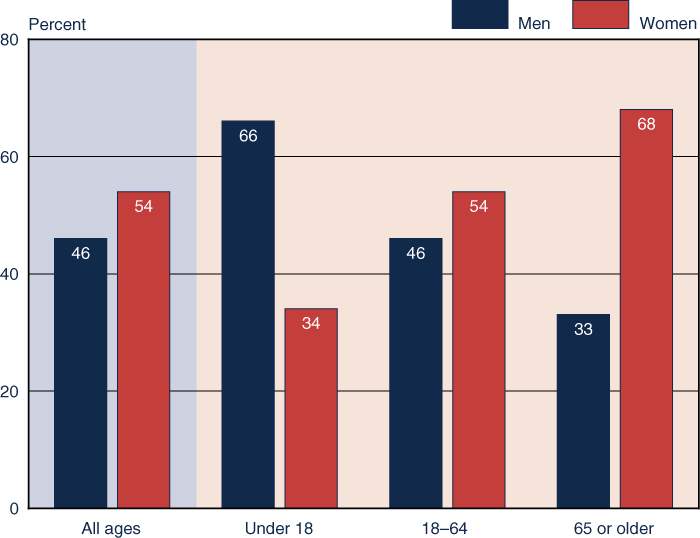
| Age | Men | Women |
|---|---|---|
| All ages | 46 | 54 |
| Under 18 | 66 | 34 |
| 18–64 | 46 | 54 |
| 65 or older | 33 | 68 |
Other Income, December 2011
Over fifty-six percent of SSI recipients aged 65 or older received OASDI benefits, as did 31.3% of those aged 18–64 and 7.6% of those under age 18. Other types of unearned income, such as income from assets, were reported most frequently among those under age 18 (20.3%) and those aged 65 or older (11.6%). Earned income was most prevalent (4.8%) among those aged 18–64.
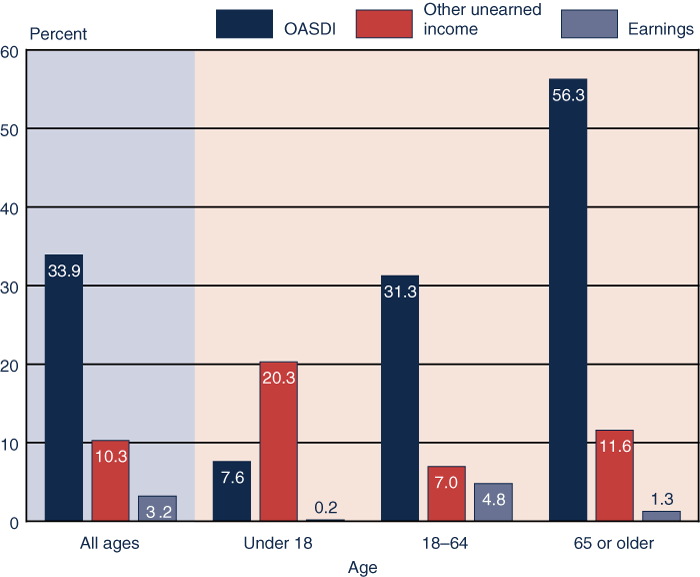
| Age | OASDI | Other unearned income |
Earnings |
|---|---|---|---|
| All ages | 33.9 | 10.3 | 3.2 |
| Under 18 | 7.6 | 20.3 | 0.2 |
| 18–64 | 31.3 | 7.0 | 4.8 |
| 65 or older | 56.3 | 11.6 | 1.3 |
Child Recipients, 1974–2011
In 1974, when the program began, 70,900 blind and disabled children were receiving SSI. That number increased to 955,000 in 1996, declined to 847,000 in 2000, and is now 1,277,122. The relatively high average payment to children (compared with payments made to blind and disabled adults) is due in part to a limited amount of other countable income. The spike in average monthly benefits in 1992 is due to retroactive payments resulting from the Sullivan v. Zebley decision. As of December 2011, blind and disabled children were receiving SSI payments averaging $601.
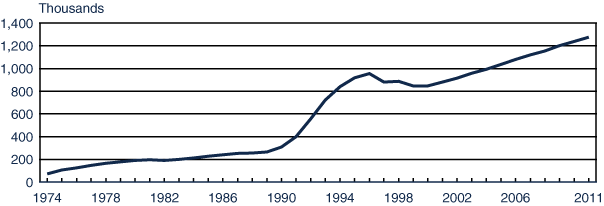
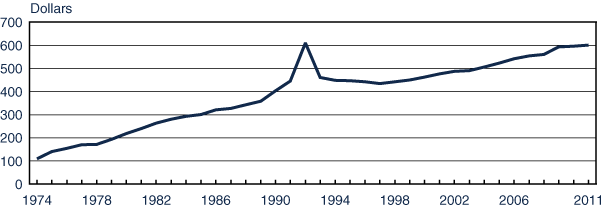
| Year | Number of children receiving SSI (in thousands) |
Average monthly SSI payment a |
|---|---|---|
| 1974 | 70.90 | 109.15 |
| 1975 | 107.03 | 141.09 |
| 1976 | 125.41 | 154.24 |
| 1977 | 147.36 | 170.03 |
| 1978 | 165.90 | 171.72 |
| 1979 | 177.31 | 193.26 |
| 1980 | 190.39 | 219.08 |
| 1981 | 194.89 | 240.84 |
| 1982 | 191.57 | 263.22 |
| 1983 | 198.32 | 280.96 |
| 1984 | 211.59 | 292.86 |
| 1985 | 227.38 | 301.26 |
| 1986 | 241.20 | 321.34 |
| 1987 | 250.90 | 327.27 |
| 1988 | 255.14 | 343.24 |
| 1989 | 264.89 | 357.64 |
| 1990 | 308.59 | 403.72 |
| 1991 | 397.16 | 446.05 |
| 1992 | 556.47 | 610.98 |
| 1993 | 722.68 | 460.54 |
| 1994 | 841.47 | 448.07 |
| 1995 | 917.05 | 447.57 |
| 1996 | 955.17 | 442.01 |
| 1997 | 879.83 | 433.83 |
| 1998 | 887.07 | 441.75 |
| 1999 | 847.06 | 450.13 |
| 2000 | 846.78 | 463.05 |
| 2001 | 881.84 | 476.09 |
| 2002 | 914.82 | 487.73 |
| 2003 | 959.38 | 490.63 |
| 2004 | 993.13 | 505.98 |
| 2005 | 1,036.50 | 522.80 |
| 2006 | 1,079.00 | 542.00 |
| 2007 | 1,121.00 | 555.00 |
| 2008 | 1,153.80 | 561.00 |
| 2009 | 1,199.79 | 593.00 |
| 2010 | 1,239.30 | 597.00 |
| 2011 | 1,277.00 | 601.00 |
| NOTE: SSI = Supplemental Security Income. | ||
Cross-Program Beneficiaries
All Beneficiaries, December 2011
About 60.4 million people received a payment from Social Security. Most (52.3 million) received OASDI benefits only, about 5.4 million received SSI only, and 2.7 million received payments from both programs.
| Benefit | Number (thousands) |
|---|---|
| Total (unduplicated) | 60,384 |
| OASDI | 55,012 |
| OASDI only | 52,271 |
| SSI | 8,113 |
| SSI only | 5,372 |
| Both OASDI and SSI | 2,741 |
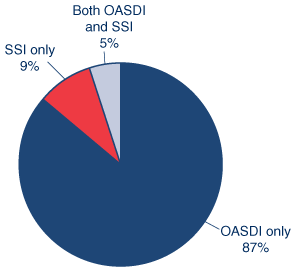
Beneficiaries Aged 65 or Older, December 2011
Benefits were paid to 39.1 million people aged 65 or older. Nearly 1.2 million received both OASDI and SSI.
| Beneficiary | Number (thousands) |
|---|---|
| Total (unduplicated) | 39,113 |
| OASDI | |
| Total | 38,213 |
| Retired workers | 32,149 |
| Disabled workers | 405 |
| Spouses | 2,051 |
| Widow(er)s | 3,530 a |
| Disabled adult children | 79 |
| OASDI only | 37,054 |
| SSI | |
| Total | 2,059 b |
| Receiving SSI only | 900 |
| Receiving both OASDI and SSI | 1,159 |
by program
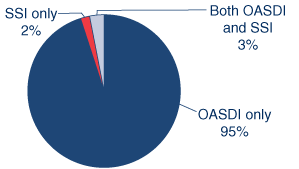
Disabled Beneficiaries Aged 18–64, December 2011
Payments were made to 12.4 million people aged 18–64 on the basis of their own disability. Sixty-two percent received disability payments from the OASDI program only, 27% received payments from the SSI program only, and 11% received payments from both programs.
| Beneficiary | Number (thousands) |
|---|---|
| Total (unduplicated) | 12,449 |
| OASDI disability | |
| Total | 9,075 |
| Workers aged 64 or younger | 8,171 |
| Disabled adult children | 791 |
| Widow(er)s | 113 |
| OASDI disability only | 7,672 |
| SSI disability | |
| Total | 4,777 |
| Receiving SSI disability only | 3,374 |
| Receiving both OASDI and SSI disability | 1,403 |
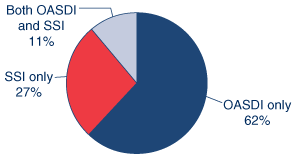
Social Security Financing
How Social Security Is Financed
Social Security is largely a pay-as-you-go program. Most of the payroll taxes collected from today's workers are used to pay benefits to today's recipients. In 2011, the Old-Age and Survivors Insurance and Disability Insurance Trust Funds collected $805.1 billion in revenues. Of that amount, 82.8% was from payroll tax contributions and reimbursements from the General Fund of the Treasury and 3.0% was from income taxes on Social Security benefits. Interest earned on the government bonds held by the trust funds provided the remaining 14.2% of income. Assets increased in 2011 because total income exceeded expenditures for benefit payments and administrative expenses.
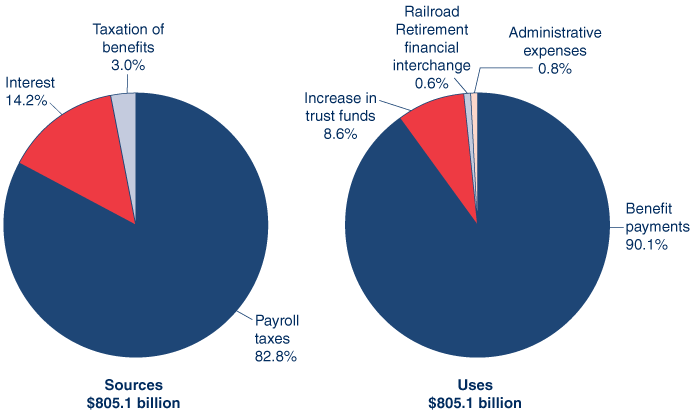
Social Security's Demographic Challenge
The 2012 Trustees Report projects that the number of retired workers will grow rapidly, as members of the post–World War II baby boom continue to reach early retirement age, and will double in fewer than 30 years. People are also living longer, and the birth rate is low. As a result, the Trustees project that the ratio of 2.9 workers paying Social Security taxes to each person collecting benefits in 2011 will fall to 2.0 to 1 in 2034. Tax and other noninterest income was not enough to cover program cost in 2010 and 2011, and the 2012 Trustees Report projects that this pattern will continue for at least 75 years. However, the Trustees also project that redemption of trust fund assets will be sufficient to allow for full payment of scheduled benefits through 2032.

The Long-Run Financial Outlook
Social Security is not sustainable over the long term at current benefit and tax rates. Beginning in 2010 and continuing in 2011, the program paid more in benefits and expenses than it collected in taxes and other noninterest income, and the 2012 Trustees Report projects this pattern to continue for the next 75 years. The Trustees estimate that the trust funds will be exhausted by 2033. At that point, payroll taxes and other income will flow into the fund but will be sufficient to pay only 75% of program costs. As reported in the 2012 Trustees Report, the projected shortfall over the next 75 years is 2.67% of taxable payroll.
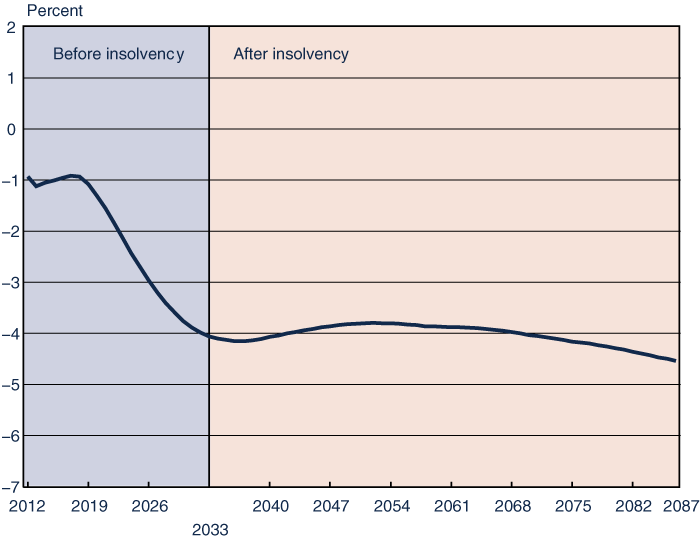
Abbreviations
- AIME
- average indexed monthly earnings
- DI
- Disability Insurance
- FICA
- Federal Insurance Contributions Act
- FRA
- full retirement age
- HI
- Hospital Insurance
- OASDI
- Old-Age, Survivors, and Disability Insurance
- OASI
- Old-Age and Survivors Insurance
- PIA
- primary insurance amount
- SECA
- Self-Employment Contributions Act
- SSA
- Social Security Administration
- SSI
- Supplemental Security Income